Planning a trip to the Aloha State? Understanding Hawaii Weather Yearly is key to ensuring you pack appropriately and choose the best time for your specific activities. Unlike many destinations with distinct four-season climates, Hawaii enjoys a relatively stable, tropical environment year-round. However, the islands experience fascinating microclimates due to their dramatic topography and prevailing trade winds, creating diverse conditions often within short distances. This guide dives into what you can expect from the weather in Hawaii throughout the year, breaking down temperatures, rainfall, and unique island variations to help you plan your perfect Hawaiian getaway.
General Hawaii Climate Patterns
Hawaii’s climate is famously mild and pleasant, primarily influenced by its tropical latitude and the prevailing trade winds. The year can generally be divided into two seasons: a drier, warmer summer period (roughly April to October) and a slightly cooler, wetter winter period (roughly November to March). However, calling them “seasons” in the traditional sense can be misleading. Rainfall often comes in brief, localized showers, especially in windward and mountainous areas. You can frequently find sunshine just a short drive away from a rain shower. This localized weather means that even if a forecast shows rain for the day, it’s unlikely to be an all-day washout across the entire island.
Understanding the role of trade winds is crucial for comprehending Hawaii Weather Yearly. These winds typically blow from the northeast or east, bringing moisture from the ocean. When these winds encounter the islands’ volcanic mountains, the air is forced upward, cooling and condensing into clouds and rain primarily on the windward (northeast and east) sides. The leeward (southwest and west) sides, sheltered by the mountains, tend to be much drier and sunnier. Occasionally, the trade winds may weaken or reverse, leading to still, humid conditions known as “Kona winds,” which can sometimes bring rain to the leeward coasts.
Understanding Hawaii’s Microclimates
One of the most unique aspects of Hawaii Weather Yearly is the presence of numerous microclimates. Due to varying elevations and the blocking effect of mountains on trade winds, different areas on the same island can have vastly different weather conditions. For example, Hilo on the windward side of the Big Island is one of the wettest cities in the United States, while the Kona side, just miles away over the mountains, is significantly drier.
Similarly, Kauai’s Mount Waiʻaleʻale is one of the wettest spots on Earth, yet the island also has relatively arid areas. This means that while statewide averages provide a general idea, checking forecasts for the specific area you plan to visit is essential for daily planning.
Elevations also play a significant role. While coastal areas enjoy consistently warm temperatures (typically 75-85°F / 24-29°C year-round), temperatures drop considerably as you gain altitude. For every 1,000 feet (305m) of elevation gain, the temperature decreases by approximately 3.5°F (about -2°C per 300m). This effect is most dramatic on the Big Island and Maui, where summits reach over 10,000 feet (3,000m). Areas like Volcano Village on the Big Island or Kokeʻe State Park on Kauai at higher elevations can be much cooler and wetter than the coast. If you plan to visit these higher areas, especially the summits of Mauna Kea or Haleakalā, be prepared for temperatures near or even below freezing, and potentially snow in winter months.
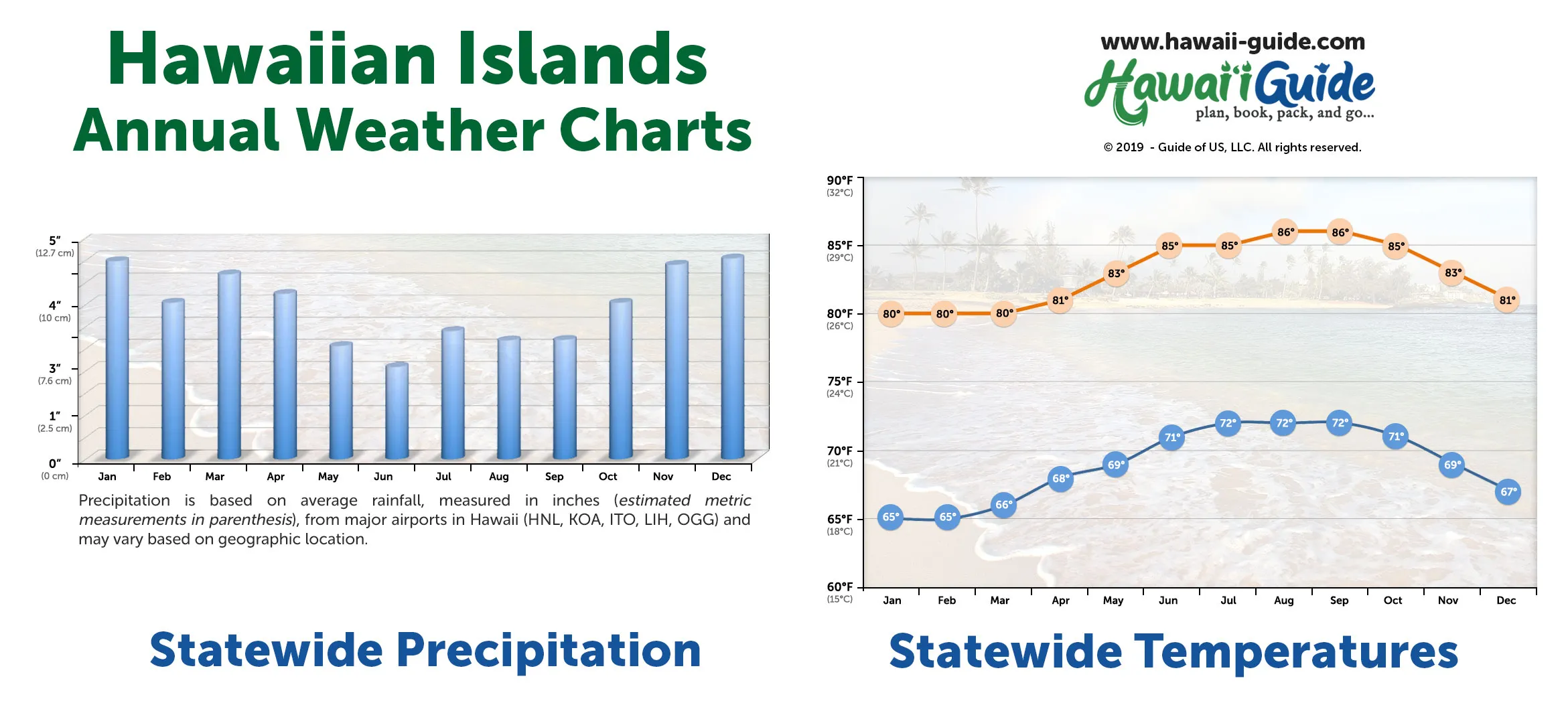
Hawaii Statewide Weather (click to enlarge)Hawaii statewide average temperatures and rainfall patterns throughout the year, crucial data for understanding Hawaii Weather Yearly.
Hawaii Weather Yearly: Annual Temperature & Rainfall Averages
Looking at the average monthly data provides a clearer picture of Hawaii Weather Yearly trends across the state. While the charts below give specific airport data (often reflecting coastal or near-coastal conditions), they illustrate the general pattern. Summer months (June-August) see average highs around 85-88°F (29-31°C) and lows around 70-74°F (21-23°C). Winter months (December-February) are slightly cooler, with average highs around 78-81°F (25-27°C) and lows around 62-67°F (16-19°C). The difference between average daytime and nighttime temperatures is relatively small throughout the year.
Finding Your Perfect Amateur Astronomy Telescope – Expert Guide 2025
Discover the Best Michigan Places to Visit for Unforgettable Adventures in 2024
Discover the Top 11 nevada places to visit
Rainfall averages show more variation. Generally, the wettest months are from November to March, and the driest are from April to September. However, the amount of rain varies significantly depending on the island and location. Coastal resort areas, especially on the leeward sides, receive much less rain than windward or mountainous regions. Even during the wetter winter months, sunshine is common, and rain showers are often brief. It’s important not to be deterred by forecasts that simply state “rain,” as this rarely means continuous precipitation.
| Hawaii Island | Jan | Feb | Mar | Apr | May | Jun | Jul | Aug | Sept | Oct | Nov | Dec |
|---|---|---|---|---|---|---|---|---|---|---|---|---|
| Statewide | 80/65°F4.5″ | 80/65°F3.5″ | 80/66°F4.2″ | 81/68°F3.7″ | 83/69°F2.6″ | 85/71°F2.0″ | 85/72°F2.9″ | 86/72°F2.7″ | 86/72°F2.7″ | 85/71°F3.5″ | 83/69°F4.4″ | 81/67°F4.5″ |
| Oahu | 80/66°F2.7″ | 81/65°F2.3″ | 82/67°F1.9″ | 83/68°F1.1″ | 85/70°F0.8″ | 87/72°F0.4″ | 88/74°F0.5″ | 89/75°F0.4″ | 89/74°F0.7″ | 87/73°F2.1″ | 84/71°F2.2″ | 82/68°F2.8″ |
| Maui | 80/63°F3.7″ | 81/63°F2.3″ | 81/65°F2.3″ | 83/66°F1.7″ | 84/67°F0.6″ | 86/69°F0.2″ | 87/71°F0.5″ | 88/71°F0.5″ | 88/70°F0.4″ | 87/69°F1.1″ | 84/68°F2.1″ | 82/65°F3.1″ |
| Kauai | 78/65°F4.5″ | 78/66°F3.2″ | 78/67°F3.5″ | 79/69°F3.0″ | 81/70°F2.8″ | 83/73°F1.8″ | 84/74°F2.1″ | 85/74°F1.9″ | 85/74°F2.6″ | 83/73°F4.2″ | 81/71°F4.7″ | 79/68°F4.7″ |
| Big Island (Kona) | 81/66°F1.7″ | 81/66°F0.9″ | 82/67°F1.1″ | 83/69°F0.5″ | 84/70°F0.6″ | 85/72°F0.4″ | 86/73°F0.6″ | 87/73°F0.8″ | 86/73°F0.7″ | 86/72°F0.6″ | 84/70°F0.9″ | 82/68°F1.8″ |
| Big Island (Hilo) | 79/64°F9.8″ | 79/64°F9.0″ | 79/65°F12.1″ | 79/66°F12.4″ | 81/67°F8.0″ | 82/68°F7.6″ | 82/69°F10.8″ | 83/69°F9.8″ | 83/69°F9.1″ | 83/69°F9.7″ | 81/67°F12.1″ | 79/65°F10.3″ |
Note: Temperatures are in Fahrenheit, precipitation in Inches. Data aggregated from airport sources provides a general estimate but conditions vary widely across each island.
Ocean temperatures around the islands are consistently warm and inviting throughout the Hawaii Weather Yearly cycle. They typically range from the low to mid-70s Fahrenheit in winter (around 74°F or 23°C) to the high 70s or low 80s Fahrenheit in summer (around 80°F or 27°C). This makes swimming, snorkeling, and other water activities comfortable no matter when you visit.
Island-Specific Weather Overview
Each Hawaiian island has its unique climate characteristics, largely influenced by its topography and how it interacts with the trade winds. Understanding these differences is key when planning your trip and interpreting Hawaii Weather Yearly data for a specific location.
Kauai Weather Yearly
Known as the “Garden Isle” for its lush landscapes, Kauai sees significant rainfall, particularly in its mountainous interior like Mount Waiʻaleʻale. However, coastal areas, especially on the south shore (like Poipu) and parts of the east coast (like Kapaʻa), are much drier and sunnier. The north shore (Princeville, Hanalei) receives more rain than the south, contributing to its dramatic greenery. Average temperatures range from around 78-85°F (25-29°C) highs and 65-74°F (18-23°C) lows throughout the year. Winter months generally see more rain showers.
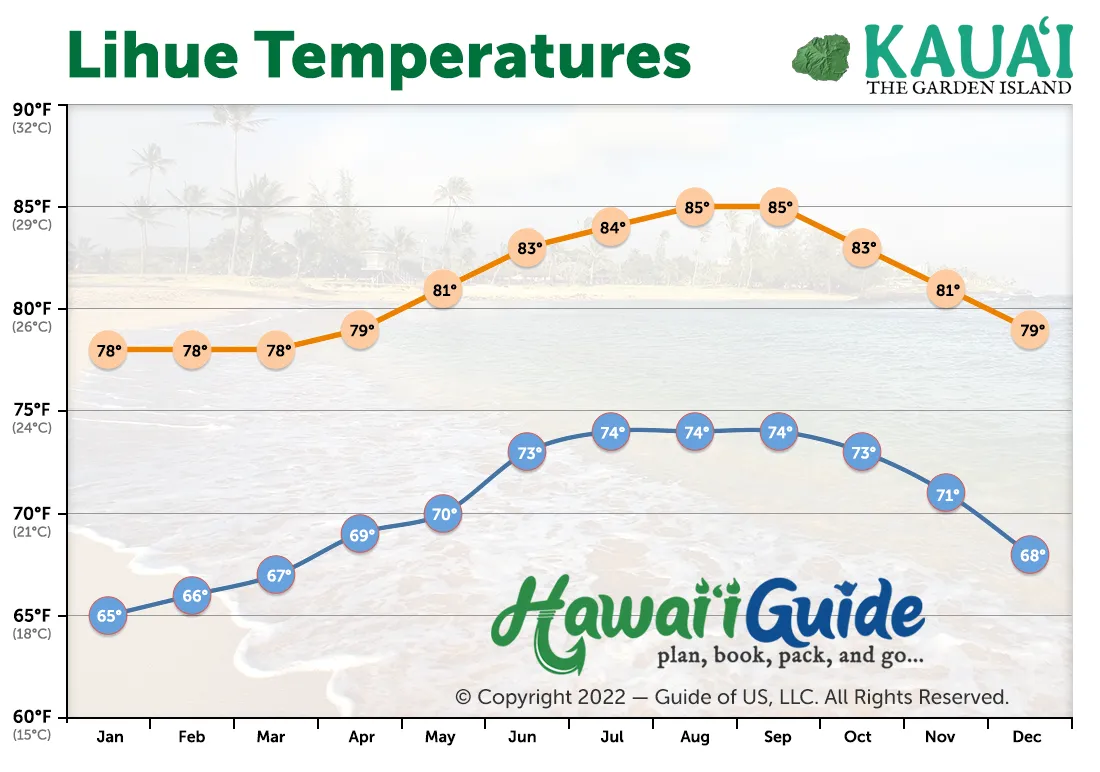 Lihue, Kauai Average TemperaturesAverage monthly temperatures recorded near Lihue, Kauai, showing the relatively consistent Hawaii Weather Yearly pattern for this island.
Lihue, Kauai Average TemperaturesAverage monthly temperatures recorded near Lihue, Kauai, showing the relatively consistent Hawaii Weather Yearly pattern for this island.
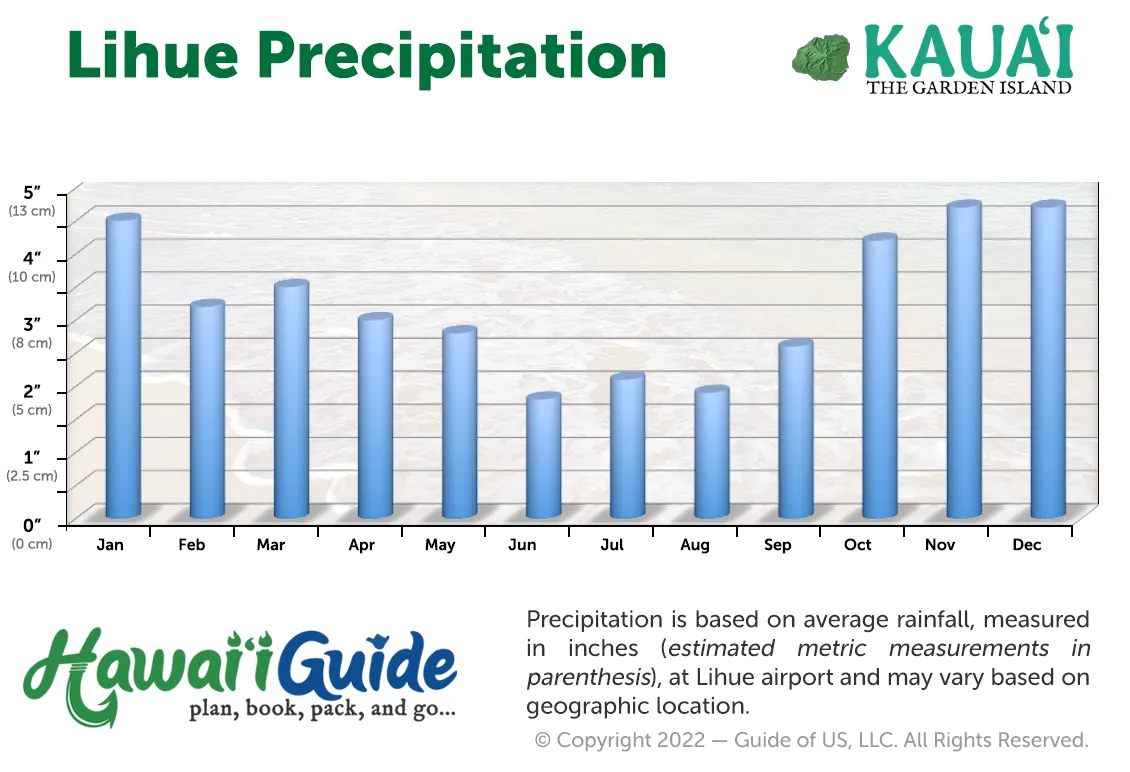 Lihue, Kauai Average PrecipitationAverage monthly precipitation near Lihue, Kauai, illustrating higher rainfall in winter months.
Lihue, Kauai Average PrecipitationAverage monthly precipitation near Lihue, Kauai, illustrating higher rainfall in winter months.
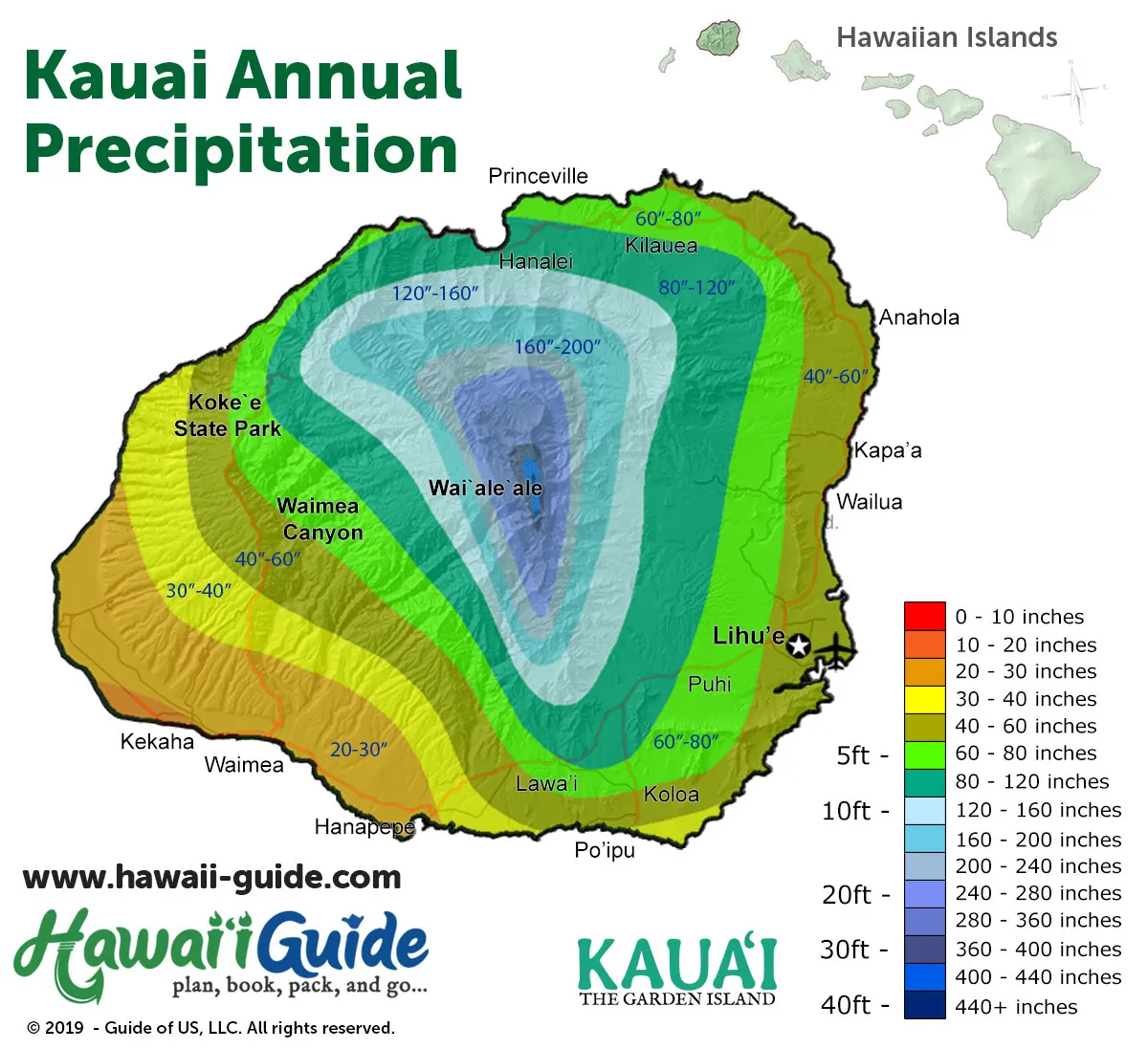 Kauai Annual Precipitation MapThis map provides a visual representation of how much rain falls across Kauai annually, highlighting the distinct wet and dry zones important for understanding Kauai’s contribution to the overall Hawaii Weather Yearly picture.
Kauai Annual Precipitation MapThis map provides a visual representation of how much rain falls across Kauai annually, highlighting the distinct wet and dry zones important for understanding Kauai’s contribution to the overall Hawaii Weather Yearly picture.
Oahu Weather Yearly
Oahu, “The Gathering Place,” home to Honolulu and Waikiki, is generally the driest of the main islands, especially along its southern and western coasts. Waikiki and Honolulu receive relatively low annual rainfall compared to other Hawaiian locations. The windward side (like Kailua and Kaneohe) is noticeably wetter and greener. The North Shore experiences different wave conditions seasonally (large waves in winter, calmer in summer) but its temperature and general climate pattern align with the rest of the island, being overall sunny. Average temperatures for Oahu range from 80-89°F (27-32°C) highs and 65-75°F (18-24°C) lows.
 Honolulu Average TemperatureAverage monthly temperatures for Honolulu, Oahu, highlighting the warm, stable temperatures characteristic of Hawaii Weather Yearly in a major urban center.
Honolulu Average TemperatureAverage monthly temperatures for Honolulu, Oahu, highlighting the warm, stable temperatures characteristic of Hawaii Weather Yearly in a major urban center.
 Honolulu Average PrecipitationAverage monthly precipitation for Honolulu, Oahu, showing relatively low rainfall compared to other islands, a key aspect of Hawaii Weather Yearly in this region.
Honolulu Average PrecipitationAverage monthly precipitation for Honolulu, Oahu, showing relatively low rainfall compared to other islands, a key aspect of Hawaii Weather Yearly in this region.
 Oahu Annual Precipitation MapAnnual rainfall distribution across Oahu, demonstrating the stark contrast between the dry south/west coasts and the wetter windward side, a crucial detail for understanding Hawaii Weather Yearly on this island.
Oahu Annual Precipitation MapAnnual rainfall distribution across Oahu, demonstrating the stark contrast between the dry south/west coasts and the wetter windward side, a crucial detail for understanding Hawaii Weather Yearly on this island.
Maui Weather Yearly
Known as “The Valley Isle,” Maui offers diverse climates. The popular resort areas of Kihei, Wailea, and Kaʻanapali on the south and west leeward coasts are dry and sunny. The central valley around Kahului experiences trade winds. The road to Hana on the windward east coast is lush and wet, featuring numerous waterfalls fed by consistent rainfall, especially in winter. The summit of Haleakalā volcano experiences alpine conditions and can be very cold, requiring warm layers even in summer. Average coastal temperatures range from 80-88°F (27-31°C) highs and 63-71°F (17-22°C) lows.
 Kahului, Maui Average TemperaturesAverage monthly temperatures near Kahului, Maui, providing insights into the temperature consistency that defines Hawaii Weather Yearly for central Maui.
Kahului, Maui Average TemperaturesAverage monthly temperatures near Kahului, Maui, providing insights into the temperature consistency that defines Hawaii Weather Yearly for central Maui.
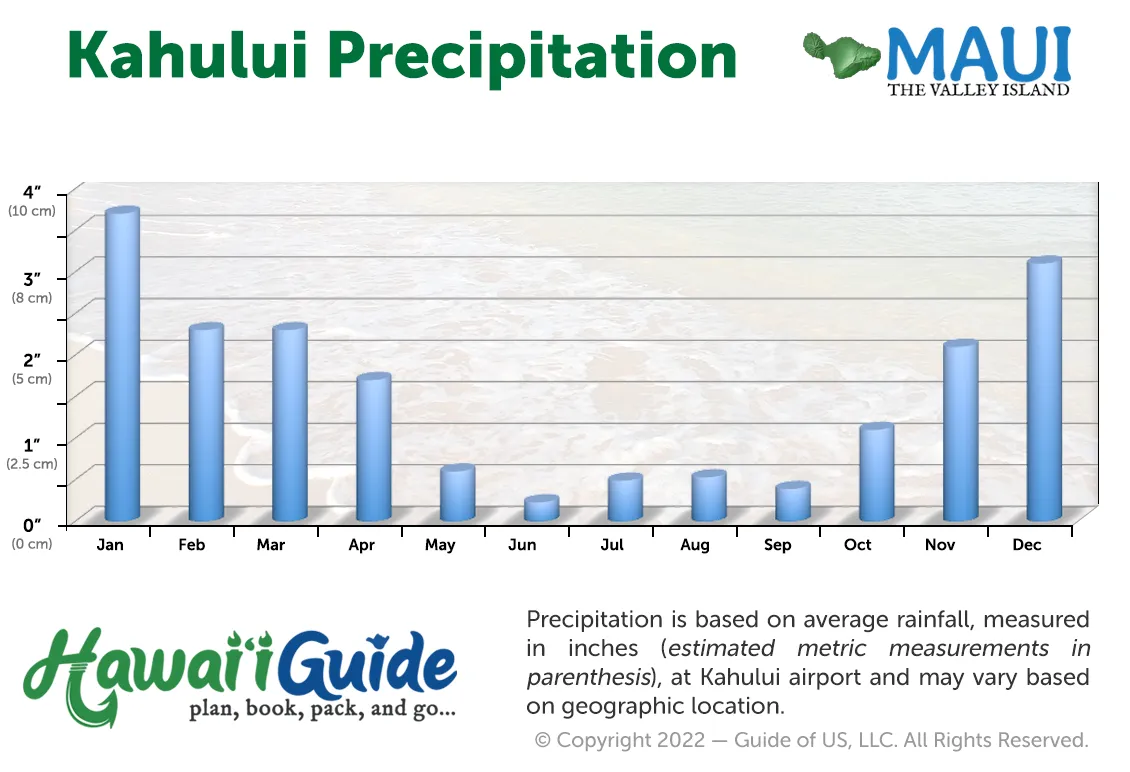 Kahului, Maui Average PrecipitationAverage monthly precipitation near Kahului, Maui, showing the influence of trade winds and some seasonal variation in rainfall.
Kahului, Maui Average PrecipitationAverage monthly precipitation near Kahului, Maui, showing the influence of trade winds and some seasonal variation in rainfall.
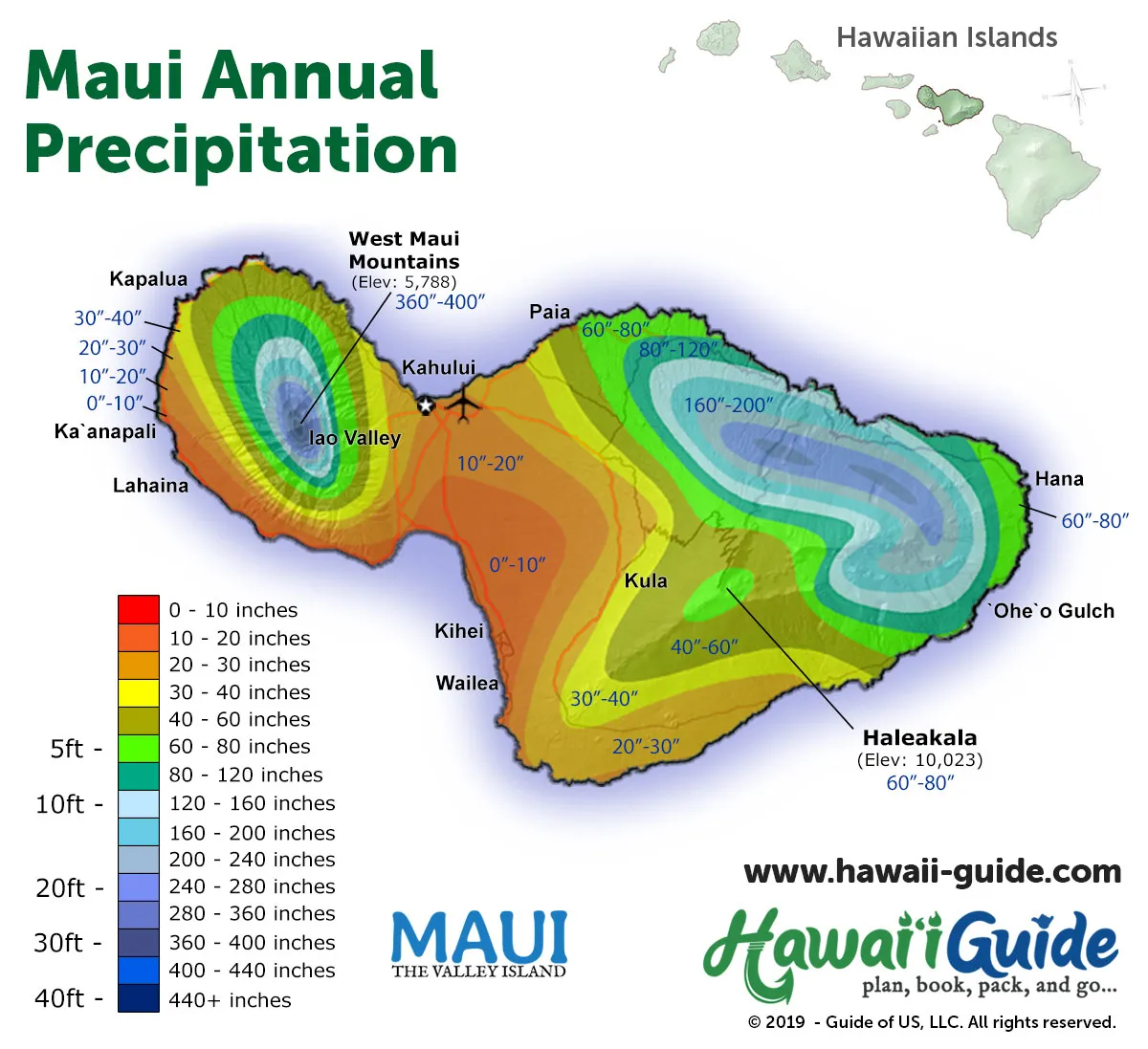 Maui Annual Precipitation MapAnnual rainfall distribution on Maui, vividly illustrating the extremely wet conditions on the windward slopes and the dry leeward coasts, essential context for comprehending Hawaii Weather Yearly variations on the island.
Maui Annual Precipitation MapAnnual rainfall distribution on Maui, vividly illustrating the extremely wet conditions on the windward slopes and the dry leeward coasts, essential context for comprehending Hawaii Weather Yearly variations on the island.
Big Island Weather Yearly
The Big Island of Hawaii is perhaps the most climatically diverse, boasting 11 out of 13 climate zones. The Kona side (west) is known for its sunny, dry weather, perfect for coffee farming and beach resorts. The Hilo side (east) is significantly wetter, with lush rainforests and frequent rain. The Volcano area (Hawaii Volcanoes National Park) is at a higher elevation and experiences cooler, often misty and rainy conditions. The summits of Mauna Kea and Mauna Loa are high enough to receive snow, sometimes experiencing blizzard conditions in winter. Coastal temperatures range from 79-87°F (26-31°C) highs and 64-73°F (18-23°C) lows, varying between the wet Hilo side and the dry Kona side.
 Kailua-Kona, West Big Island Average TemperaturesAverage monthly temperatures for Kailua-Kona on the Big Island’s west coast, showcasing the warm, stable conditions typical of the leeward side and contributing to the overall understanding of Hawaii Weather Yearly.
Kailua-Kona, West Big Island Average TemperaturesAverage monthly temperatures for Kailua-Kona on the Big Island’s west coast, showcasing the warm, stable conditions typical of the leeward side and contributing to the overall understanding of Hawaii Weather Yearly.
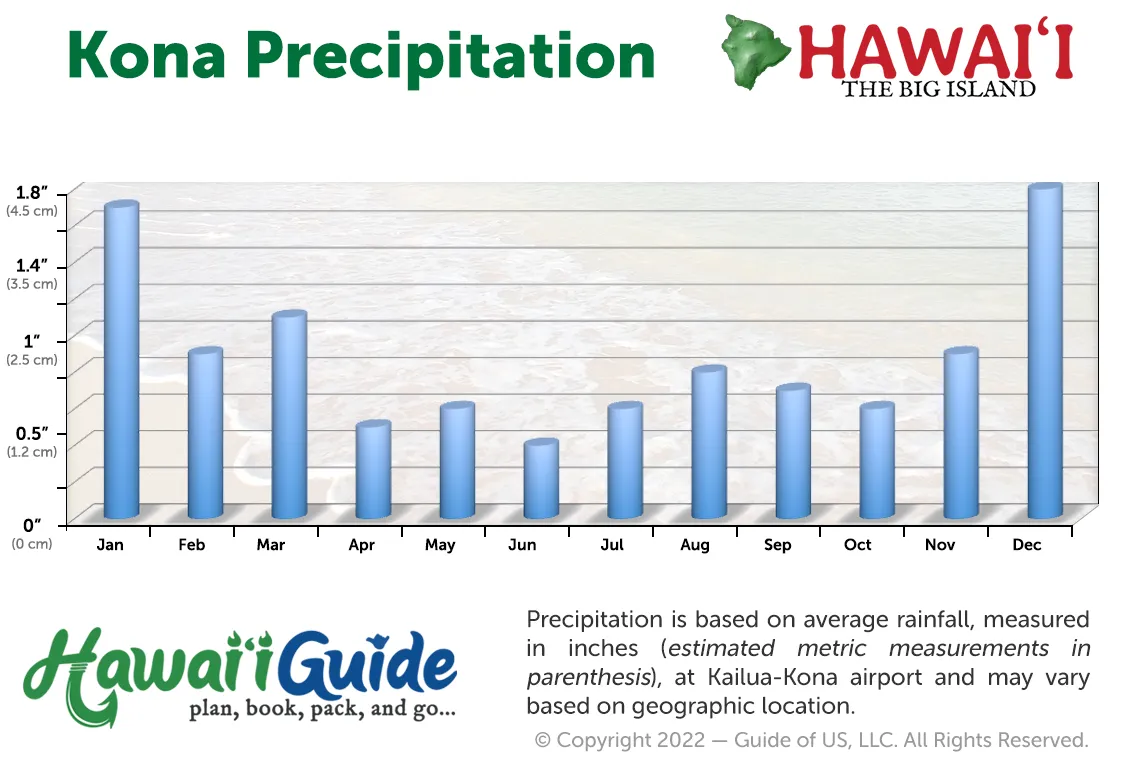 Kailua-Kona, West Big Island Average PrecipitationAverage monthly precipitation for Kailua-Kona, indicating the dry climate characteristic of the Big Island’s leeward coast.
Kailua-Kona, West Big Island Average PrecipitationAverage monthly precipitation for Kailua-Kona, indicating the dry climate characteristic of the Big Island’s leeward coast.
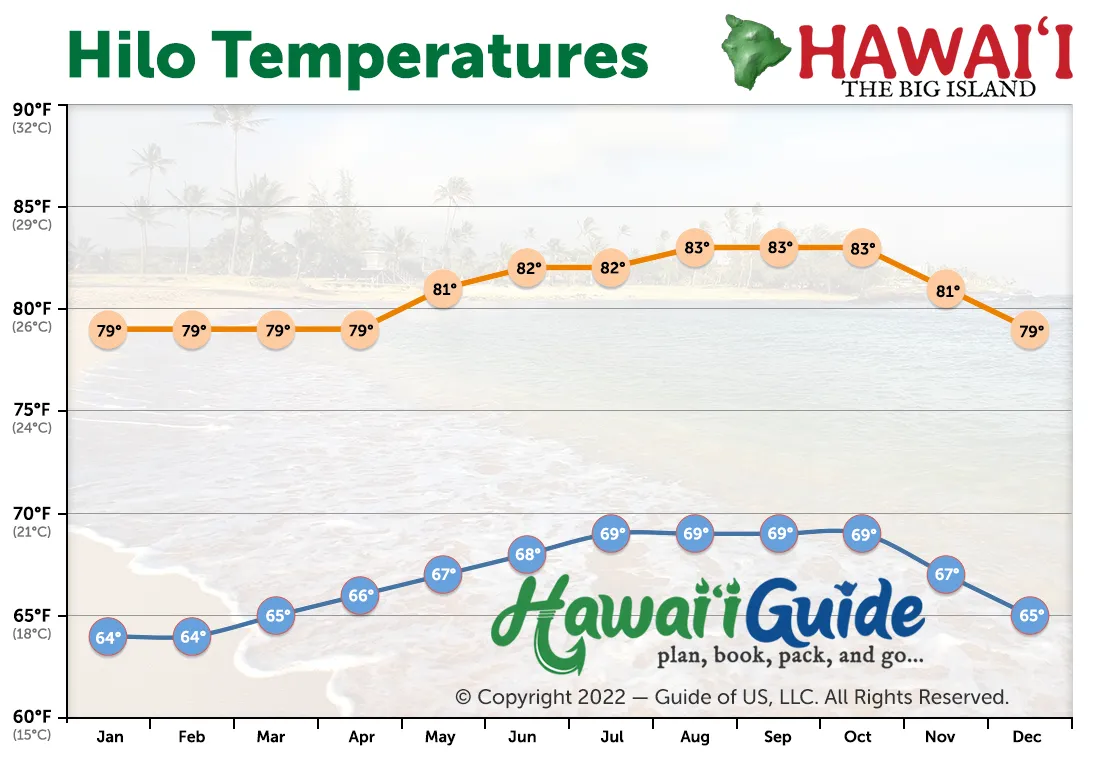 Hilo, East Big Island Average TemperatureAverage monthly temperatures for Hilo on the Big Island’s east coast, showing slightly cooler temperatures compared to Kona, reflecting its windward location and influence on Hawaii Weather Yearly.
Hilo, East Big Island Average TemperatureAverage monthly temperatures for Hilo on the Big Island’s east coast, showing slightly cooler temperatures compared to Kona, reflecting its windward location and influence on Hawaii Weather Yearly.
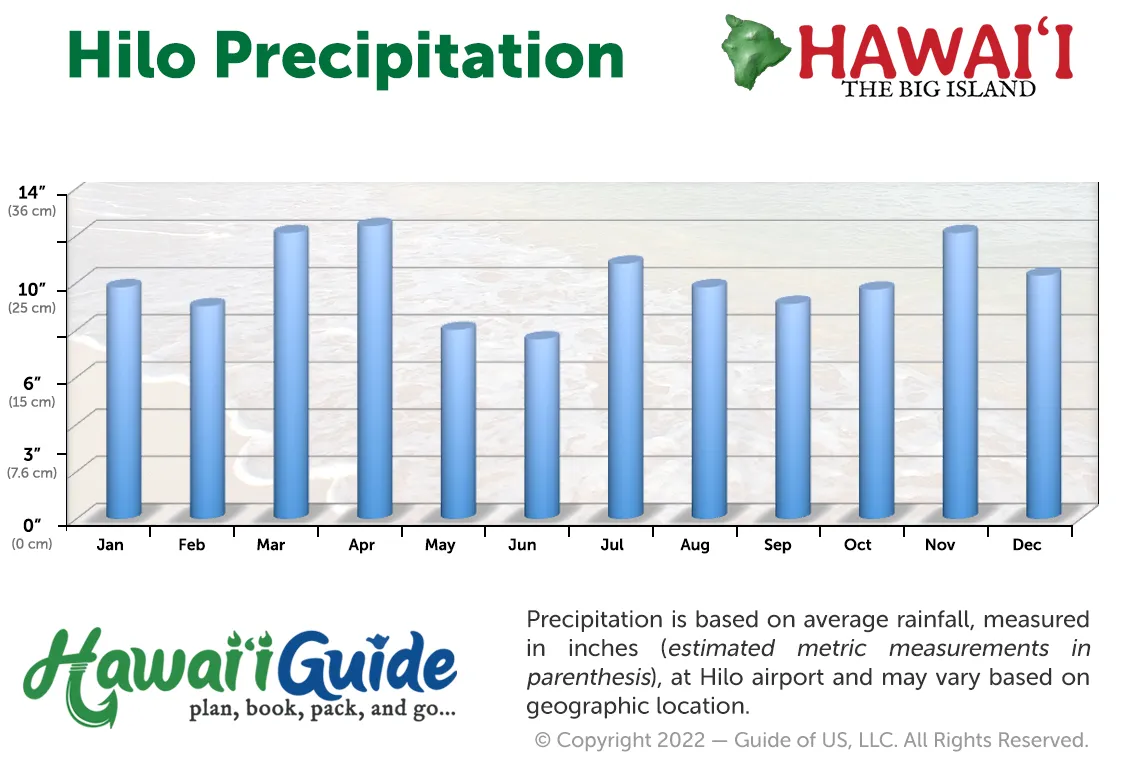 Hilo, East Big Island Average PrecipitationAverage monthly precipitation for Hilo, illustrating the exceptionally high rainfall on the Big Island’s windward side, a significant factor in the Hawaii Weather Yearly climate.
Hilo, East Big Island Average PrecipitationAverage monthly precipitation for Hilo, illustrating the exceptionally high rainfall on the Big Island’s windward side, a significant factor in the Hawaii Weather Yearly climate.
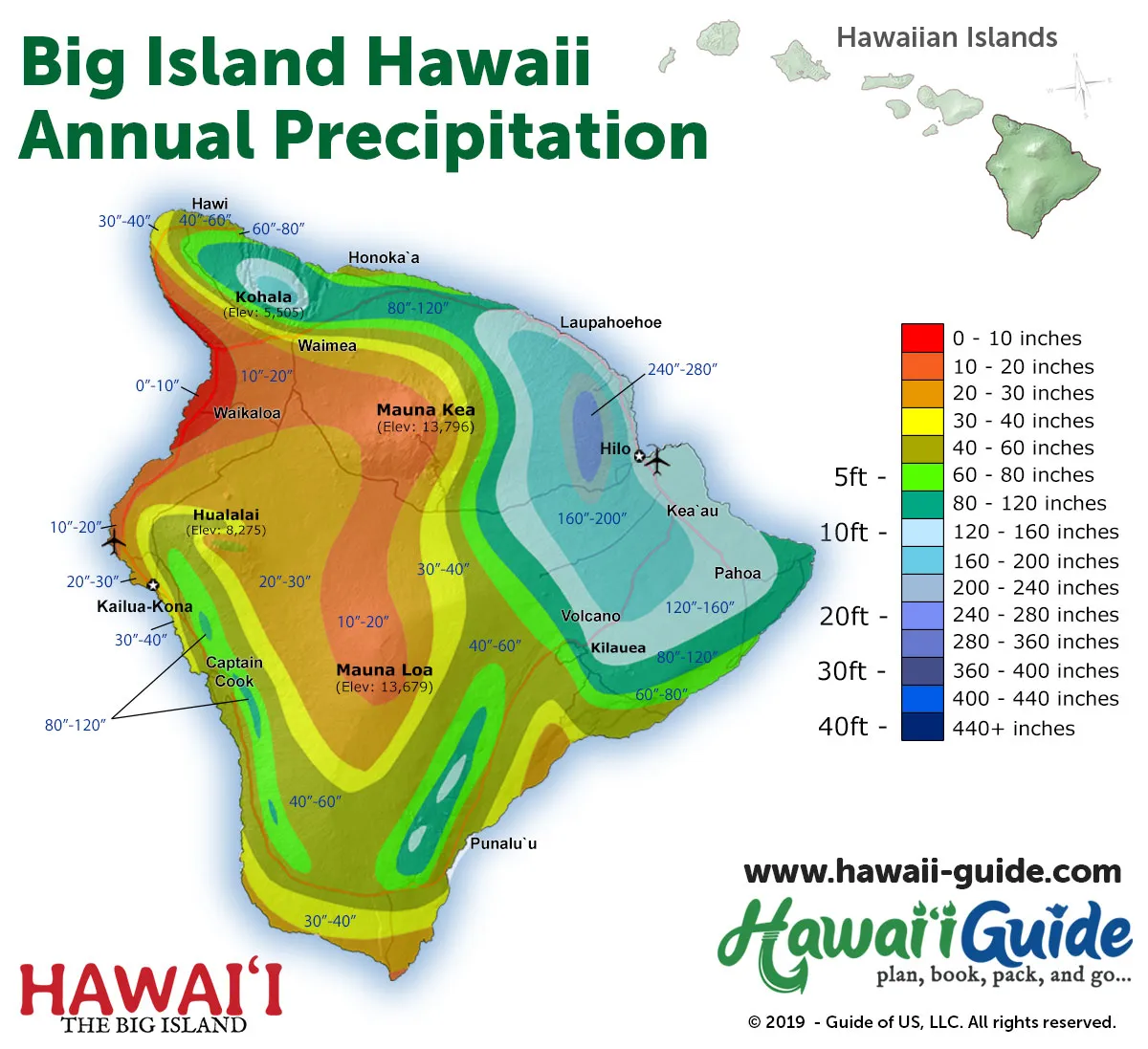 Big Island Annual Precipitation MapThis map details the annual rainfall distribution across the Big Island, highlighting the dramatic difference between the wet Hilo side and the dry Kona side, crucial for comprehending the Big Island’s unique contribution to Hawaii Weather Yearly diversity.
Big Island Annual Precipitation MapThis map details the annual rainfall distribution across the Big Island, highlighting the dramatic difference between the wet Hilo side and the dry Kona side, crucial for comprehending the Big Island’s unique contribution to Hawaii Weather Yearly diversity.
Seasonal Factors and Special Weather Events
While Hawaii doesn’t have traditional seasons, certain times of the year are associated with specific weather patterns. As noted, winter (Nov-Mar) tends to be wetter, especially on windward coasts, and can bring larger surf to north shores. Summer (Apr-Oct) is generally drier, hotter, and calmer.
El Niño and La Niña cycles can influence Hawaii Weather Yearly. During El Niño years, Hawaii often experiences drier than average winter months. Conversely, La Niña years tend to bring more rainfall, potentially extending the “wet” period further into spring.
Hurricane season in Hawaii runs from June 1st to November 30th. While direct hurricane hits are rare due to cooler waters and atmospheric conditions west of the islands, tropical storms and hurricanes forming in the Eastern Pacific can occasionally track near enough to bring increased humidity, strong winds, heavy rain, and high surf. It’s important to monitor forecasts if traveling during this period, though the vast majority of tropical cyclones pass harmlessly south or west of the islands.
Preparing for Hawaii’s Climate
Given the diverse and sometimes unpredictable nature of Hawaii Weather Yearly, packing strategically is advisable. Lightweight clothing is suitable year-round for coastal areas. Even in winter, a light jacket or sweater is usually sufficient for evenings or indoor air conditioning. However, if you plan to visit higher elevations (like Volcano on the Big Island, Kokeʻe on Kauai, or anywhere inland above 3,000 ft), pack warmer layers, including a jacket, long pants, and perhaps a hat. For mountain summit visits, treat it like a cold-weather excursion, even in summer.
Bringing a small, packable rain poncho is also a good idea for hikes or exploring lush areas, as showers can appear quickly. Remember that even if it rains, it’s often followed quickly by sunshine!
Frequently Asked Questions about Hawaii Weather Yearly
Q: Is there a best time to visit Hawaii based on weather?
A: The best time depends on your priorities. For the driest, sunniest weather, aim for the summer months (April to October). For potentially lower prices and fewer crowds (outside of holidays), or for experiencing big wave surfing on north shores, the winter months (November to March) might be appealing, just be prepared for more potential rain, especially on windward coasts. Temperatures are pleasant year-round.
Q: Does it rain all day in Hawaii during the “rainy season”?
A: Rarely. While the winter months see more rainfall, it typically comes in short, localized showers, often passing quickly, especially in resort areas. Prolonged, all-day rain is uncommon on the leeward coasts where most accommodations are located.
Q: How much does the temperature change from day to night?
A: At sea level, the temperature difference between day and night is usually only about 10-15°F (6-8°C) throughout the year. However, this difference can be more pronounced at higher elevations.
Q: Are some islands drier than others?
A: Yes, Oahu (especially Honolulu) is generally the driest of the main islands. The leeward coasts of all islands are significantly drier than their windward sides.
Q: Do I need a jacket in Hawaii?
A: For coastal areas, probably not needed during the day, and a light layer might suffice for evenings. However, if you plan to visit higher elevations (like volcanoes, mountain parks, or upcountry areas), a jacket is definitely recommended, and warmer gear is essential for summit visits.
Conclusion
Exploring Hawaii Weather Yearly reveals a fascinating climate tapestry woven from tropical warmth, trade winds, and dramatic volcanic topography. While forecasts might sometimes look daunting, the reality is often a quickly changing mix of sun and brief showers, with plenty of warmth for enjoying the beaches and ocean. By understanding the general patterns, the influence of microclimates and elevation, and checking specific local forecasts for your destination, you can confidently plan your visit and experience the diverse beauty of Hawaii’s climate firsthand. Don’t let the chance of a shower deter you; the rainbows are often just around the corner!
